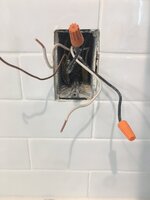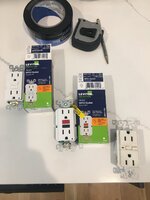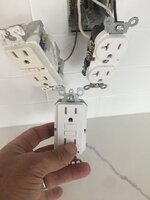This has me completely stumped.
Swapping out receptacles the kitchen.
Current setup:
We have one run of receptacles that is fed by another thru a GFI receptacle. Works great. Bottom run is hot and goes into the bottom of the existing receptacle. Down the line run attaches to the top connectors.
No matter which NEW gfi receptacle I've tried (6 different ones so far) I can't reproduce this same setup. Even attaching just the hot like to the bottom of the new receptacle doesn't result in a working receptacle. I see a green light but it doesn't power anything that I plug into it. I am completely confused why that would be. Am I doing something wrong? I pressed reset and test buttons and nothing. TIA for any advice.
Pics.
First is my wiring
Second are some of the receptacles I tried and bottom right is the original working one.
Third one is me trying but a regular non gfi plug and it does power the done the line plugs so it's something with the new GFI plugs I am trying to use.



Swapping out receptacles the kitchen.
Current setup:
We have one run of receptacles that is fed by another thru a GFI receptacle. Works great. Bottom run is hot and goes into the bottom of the existing receptacle. Down the line run attaches to the top connectors.
No matter which NEW gfi receptacle I've tried (6 different ones so far) I can't reproduce this same setup. Even attaching just the hot like to the bottom of the new receptacle doesn't result in a working receptacle. I see a green light but it doesn't power anything that I plug into it. I am completely confused why that would be. Am I doing something wrong? I pressed reset and test buttons and nothing. TIA for any advice.
Pics.
First is my wiring
Second are some of the receptacles I tried and bottom right is the original working one.
Third one is me trying but a regular non gfi plug and it does power the done the line plugs so it's something with the new GFI plugs I am trying to use.














